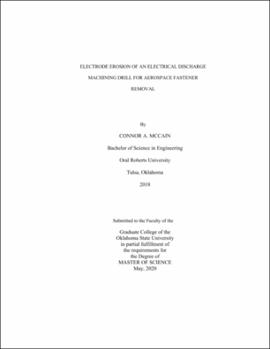| dc.description.abstract | This paper presents an examination of an electrical discharge machining hand drill system for aerospace fastener removal purposes to define secondary level influence of cut depth, electrode diameter, and fastener material type on electrode erosion. In aircraft engine maintenance, repair, and overhaul, even slight process improvements can have a large economic impact. Conventional methods for fastener removal often require use of a mechanical drill, which presents issues with the normal force required, accumulations of small-piece debris, long process times, and damage to parent material. Although the technology of electrical discharge machining has been utilized for decades, it is now being used as a novel solution for removing aerospace fasteners to minimize normal force required, decrease process time, and contain debris. Algorithms have been developed for these systems using mathematical models and experimental testing to estimate the electrode erosion rate during the machining process, but some secondary level variable process influencers are not currently defined. A statistics-based study was performed here to examine electrode erosion rates at varying cut depths from 0.05 to 0.15 inches, relevant electrode diameters from 0.1250 to 0.3300 inches, and workpiece material type (Titanium and Inconel). The experimental data was evaluated using seven parameters: cut time, axial electrode wear, radial electrode wear, electrode wear ratio (a volume change comparison between the fastener material and the electrode), material removal rate (a measure of the mass removed over time), cross-section area difference, and cut depth difference. The most important parameters were found to be axial electrode wear and electrode wear ratio. Results from the study show the rate of axial electrode wear and electrode wear ratio both increase due to cut depth and changing fastener materials from Titanium to Inconel. Axial electrode wear was shown to increase as the electrode diameter was decreased, while electrode wear ratio was shown to increase and then decrease as electrode diameter was increased. Using the data from the study, a rudimentary empirical electrode life prediction was developed, but significant error causes a low confidence level. It is shown that a linear approximation for electrode wear is sufficient for cuts into Inconel fasteners. Analysis of the linear, exponential, weighted polynomial, and geometric volume models of the Titanium cuts show the present data is not sufficient for predicting electrode wear on cuts into Titanium fasteners. | |
